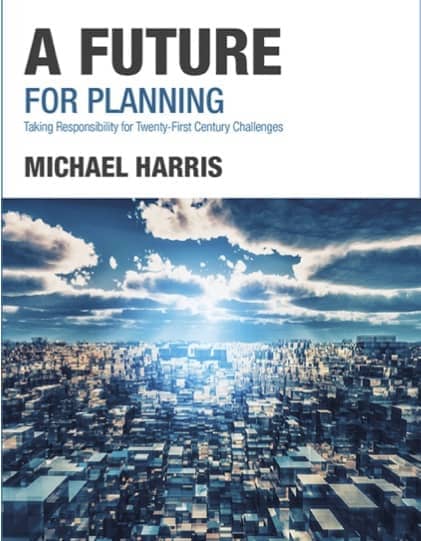
www.buildingsandcities.org/insights/reviews/future-for-planning-review.html
A Future for Planning: Taking Responsibility for Twenty-First Century Challenges
By Michael Harris. Routledge, 2019, ISBN: 9781138708808
Gerald Mills reviews this book on how planning theory and practice have changed, and whether they are equipped to tackle the challenges of climate change.
This book is based on a series of papers that were published to recognize the 100th anniversary of the foundation of the Royal Town Planning Institute (RTPI) which is a Chartered Institute that accredits planning courses nationally and internationally and maintains professional standards. The series was entitled 'Planning Horizons' and focused on the evolving status of planning (as an idea and practice) in the UK and how it has changed over the last century. The premise of the book is that repeated ideological attacks on planning theory and practice have left it ill-prepared to deal with the climate crisis and the comprehensive response that is needed.
The structure of the book is divided into two parts. The first part is devoted to a historical analysis of the changing status, roles and influence of planning since the beginning of the 20th century. While the focus of this part is on the UK, the influences on planning as a profession are common in western societies characterized by neo-liberal approaches to public services. This section analyses the causes of the crisis in planning, and makes the case for a new progressive planning to cope with global environmental challenges, notably climate change. The second part of the book provides international case-studies that demonstrate how integrated, long-term and inclusive planning can address these challenges. As the author writes:
This book is not a 'how to' plan for the future… Rather it is about how, despite uncertainties, it is possible to plan, contrary to a widespread planning pessimism that has been promoted by some of the fiercest and most determined opponents of planning, particularly neoliberals. It is a critical defence of the idea of planning, especially planning for the long-term
The first part of the book comprises five chapters on how official planning has changed from its beginnings as a profession that was expert-led and focused on the management of land-uses for the improvement of society. The diminution of its standing and ability to plan is attributed to the rise of the New Right, which characterized planning practice as authoritarian, inefficient and based on the false premise that one could predict the future. Inspired by the economics of Friedrich Hayek, they argued for market-led development as the only rational basis for land-use management. It follows that interference in this process for longer term societal benefit, broadly defined, could not be justified based on expert insights. The success of this perspective has made planning policy and practice short-sighted, limited in scope and ambition and incapable of dealing with long-term and knowable threats, such as those associated with climate change. To illustrate these points, the author initially draws on a diverse set of planning failures such as the financial crisis of 2008 but then shifts to evolving responses to attacks by the New Right (and left) in urban and regional planning.
As the author states:
The story of post-war planning presented here, focusing on the UK but echoed in many other countries, is from certainty to uncertainty, from popular political visions of a better society and a confidence in how this could be achieved, to increasing external and internal criticism and self-doubt. This has resulted in a lack of political and public visibility and confidence in planning, and a widespread short-termism which leaves us largely unprepared for the future we now face.
The second part of the book consists of two chapters that present cases studies that have been selected to illustrate different points: that we have enough knowledge of the future to act; that decision-making systems must take an integrated and longer-term perspective and; that citizen engagement is necessary to build public support. The case studies include: Rotterdam and its history of water management; New York and its sustainability plan (PlaNYC/OneNYC) that is both integrated and responds to climate change projections; Singapore and its use of scenario-based approaches to plan for the future; Seychelles and its use of public participation; Germany and its restructuring of the energy system (Energiewende) to allow citizen energy production and; community-led strategies based on local actions. The final chapter of the book has the subtitle 'Planning for the Long Term in an Age of Crisis and Short-Termism', which summarizes the case for renewal of planning practice.
The diagnosis presented by the author for the state of planning is coherent and the need for a long-term perspective to address the major issue of our times is compelling. Clearly, the short-term thinking associated with, and advocated by, the New Right perspective is not capable of dealing with the multi-scalar decisions needed to deal with climate change; in fact, one could argue that it has accentuated the drivers and enhanced the risks through land-use management. I do think that part of the difficulty associated with planning for climate change is that the scale of the problem is vast and that the integrated approach needed to address climate change is so comprehensive that it affects all aspects of 'developed' societies. In the examples presented in the book, it would have been helpful to use environmental case-studies to bolster the arguments for progressive planning. For example, climate change is driven by the emission of greenhouse gases which are not generally seen as air pollutants that affect people's health (and are not measured as such). By comparison, there are well established systems for managing local air quality based on observations, understanding and responses. The latter include land-use zoning, technological controls and behaviour modification many of which are equally applicable to managing emissions associated with climate change. The difference is that air quality can be directly related to public health in the short-term and is often readily detectable by sight or smell. At a different scale, ozone depletion is probably regarded as an exemplar of global environmental management, which was led by scientific evidence that was quite complex. The solution (banning a class of manufactured chemicals) was relatively easy in that it required inter-governmental co-operation with limited citizen participation. So, dealing with climate change that challenges the foundation of modern economies that are connected by the transfer of resources over global scales is a different order of problem.
One issue that could have been given more prominence in the book is the issue of scale of action, which is implied in the case-study examples but could be made explicit. One of the problems with overcoming the 'fatalism' associated with climate change and the difficulty in getting people to accept a long-term view is that the actions and consequences are not strongly connected and that actions by individuals, communities and countries can be undermined by those of others. So, we need a planning toolkit that can both accommodate place-making at local scales and place these decisions in the context of regional and global changes. The case-studies in the book provide examples of techniques that can build participatory frameworks to address this issue. A Future for Planning was published just before the Covid pandemic; it would have been interesting to hear the author's take on its management in the context of greatly restricted movements of people and the renewed interest in the neighbourhood and the local environment that emerged.
As a physical geographer and non-expert in the planning field, I found A Future for Planning to be an insightful and provocative read and challenged my views on the prospects and challenges for planning for climate change. I was especially taken by the challenge presented to academics to provide direction and leadership on the planning that is needed for coping with the challenges we face and to provide solutions for planning practice. I teach courses on climate change and the urban environment at my home university and I will be modifying several of my lectures to incorporate the ideas introduced in this book.
Latest Peer-Reviewed Journal Content
Acceptability of sufficiency consumption policies by Finnish households
E Nuorivaara & S Ahvenharju
Key factors for revitalising heritage buildings through adaptive reuse
É Savoie, J P Sapinski & A-M Laroche
Cooler streets for a cycleable city: assessing policy alignment
C Tang & J Bush
Understanding the embodied carbon credentials of modern methods of construction
R O'Hegarty, A McCarthy, J O'Hagan, T Thanapornpakornsin, S Raffoul & O Kinnane
The changing typology of urban apartment buildings in Aurinkolahti
S Meriläinen & A Tervo
Embodied climate impacts in urban development: a neighbourhood case study
S Sjökvist, N Francart, M Balouktsi & H Birgisdottir
Environmental effects of urban wind energy harvesting: a review
I Tsionas, M laguno-Munitxa & A Stephan
Office environment and employee differences by company health management certification
S Arata, M Sugiuchi, T Ikaga, Y Shiraishi, T Hayashi, S Ando & S Kawakubo
Spatiotemporal evaluation of embodied carbon in urban residential development
I Talvitie, A Amiri & S Junnila
Energy sufficiency in buildings and cities: current research, future directions [editorial]
M Sahakian, T Fawcett & S Darby
Sufficiency, consumption patterns and limits: a survey of French households
J Bouillet & C Grandclément
Health inequalities and indoor environments: research challenges and priorities [editorial]
M Ucci & A Mavrogianni
Operationalising energy sufficiency for low-carbon built environments in urbanising India
A B Lall & G Sethi
Promoting practices of sufficiency: reprogramming resource-intensive material arrangements
T H Christensen, L K Aagaard, A K Juvik, C Samson & K Gram-Hanssen
Culture change in the UK construction industry: an anthropological perspective
I Tellam
Are people willing to share living space? Household preferences in Finland
E Ruokamo, E Kylkilahti, M Lettenmeier & A Toppinen
Towards urban LCA: examining densification alternatives for a residential neighbourhood
M Moisio, E Salmio, T Kaasalainen, S Huuhka, A Räsänen, J Lahdensivu, M Leppänen & P Kuula
A population-level framework to estimate unequal exposure to indoor heat and air pollution
R Cole, C H Simpson, L Ferguson, P Symonds, J Taylor, C Heaviside, P Murage, H L Macintyre, S Hajat, A Mavrogianni & M Davies
Finnish glazed balconies: residents' experience, wellbeing and use
L Jegard, R Castaño-Rosa, S Kilpeläinen & S Pelsmakers
Modelling Nigerian residential dwellings: bottom-up approach and scenario analysis
C C Nwagwu, S Akin & E G Hertwich
Mapping municipal land policies: applications of flexible zoning for densification
V Götze, J-D Gerber & M Jehling
Energy sufficiency and recognition justice: a study of household consumption
A Guilbert
Linking housing, socio-demographic, environmental and mental health data at scale
P Symonds, C H Simpson, G Petrou, L Ferguson, A Mavrogianni & M Davies
Measuring health inequities due to housing characteristics
K Govertsen & M Kane
Provide or prevent? Exploring sufficiency imaginaries within Danish systems of provision
L K Aagaard & T H Christensen
Imagining sufficiency through collective changes as satisfiers
O Moynat & M Sahakian
US urban land-use reform: a strategy for energy sufficiency
Z M Subin, J Lombardi, R Muralidharan, J Korn, J Malik, T Pullen, M Wei & T Hong
Mapping supply chains for energy retrofit
F Wade & Y Han
Operationalising building-related energy sufficiency measures in SMEs
I Fouiteh, J D Cabrera Santelices, A Susini & M K Patel
Promoting neighbourhood sharing: infrastructures of convenience and community
A Huber, H Heinrichs & M Jaeger-Erben
New insights into thermal comfort sufficiency in dwellings
G van Moeseke, D de Grave, A Anciaux, J Sobczak & G Wallenborn
'Rightsize': a housing design game for spatial and energy sufficiency
P Graham, P Nourian, E Warwick & M Gath-Morad
Implementing housing policies for a sufficient lifestyle
M Bagheri, L Roth, L Siebke, C Rohde & H-J Linke
The jobs of climate adaptation
T Denham, L Rickards & O Ajulo
Structural barriers to sufficiency: the contribution of research on elites
M Koch, K Emilsson, J Lee & H Johansson
Disrupting the imaginaries of urban action to deliver just adaptation [editorial]
V Castán-Broto, M Olazabal & G Ziervogel
Nature for resilience reconfigured: global- to-local translation of frames in Africa
K Rochell, H Bulkeley & H Runhaar
How hegemonic discourses of sustainability influence urban climate action
V Castán Broto, L Westman & P Huang
Fabric first: is it still the right approach?
N Eyre, T Fawcett, M Topouzi, G Killip, T Oreszczyn, K Jenkinson & J Rosenow
Social value of the built environment [editorial]
F Samuel & K Watson
Understanding demolition [editorial]
S Huuhka
Data politics in the built environment [editorial]
A Karvonen & T Hargreaves



Latest Commentaries
Decolonising Cities: The Role of Street Naming
During colonialisation, street names were drawn from historical and societal contexts of the colonisers. Street nomenclature deployed by colonial administrators has a role in legitimising historical narratives and decentring local languages, cultures and heritage. Buyana Kareem examines street renaming as an important element of decolonisation.
Integrating Nature into Cities
Increasing vegetation and green and blue spaces in cities can support both climate change mitigation and adaptation goals, while also enhancing biodiversity and ecological health. Maibritt Pedersen Zari (Auckland University of Technology) explains why nature-based solutions (NbS) must be a vital part of urban planning and design.